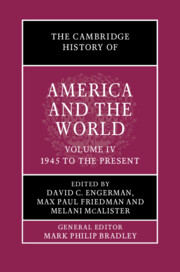Book contents
- The Cambridge History of America and the World
- The Cambridge History of America and the World
- The Cambridge History of America and the World
- Copyright page
- Contents
- Figures
- Maps
- Contributors to Volume IV
- General Introduction: What is America and the World?
- Introduction to Volume IV
- Part I Ordering a World of States
- Part II Challenging a World of States
- 10 US Foreign Policy and the End of Development
- 11 Oil and American Insecurity
- 12 US Mass Culture and Consumption in a Global Context
- 13 Imperial Visions of the World
- 14 Human Rights
- 15 Compassion and Humanitarianism in International Relations
- 16 Third World Internationalism and the Global Color Line
- 17 The Queering of US Geopolitics
- 18 Migration, War, and the Transformation of the US Population
- 19 Christian and Muslim Transnational Networks
- 20 Native Americans, Indigeneity, and US Foreign Policy
- 21 Environment, Climate, and Global Disorder
- 22 Détente and the Reconfiguration of Superpower Relations
- Part III New World Disorder?
- Index
21 - Environment, Climate, and Global Disorder
from Part II - Challenging a World of States
Published online by Cambridge University Press: 12 November 2021
- The Cambridge History of America and the World
- The Cambridge History of America and the World
- The Cambridge History of America and the World
- Copyright page
- Contents
- Figures
- Maps
- Contributors to Volume IV
- General Introduction: What is America and the World?
- Introduction to Volume IV
- Part I Ordering a World of States
- Part II Challenging a World of States
- 10 US Foreign Policy and the End of Development
- 11 Oil and American Insecurity
- 12 US Mass Culture and Consumption in a Global Context
- 13 Imperial Visions of the World
- 14 Human Rights
- 15 Compassion and Humanitarianism in International Relations
- 16 Third World Internationalism and the Global Color Line
- 17 The Queering of US Geopolitics
- 18 Migration, War, and the Transformation of the US Population
- 19 Christian and Muslim Transnational Networks
- 20 Native Americans, Indigeneity, and US Foreign Policy
- 21 Environment, Climate, and Global Disorder
- 22 Détente and the Reconfiguration of Superpower Relations
- Part III New World Disorder?
- Index
Summary
This chapter analyzes the relationship between US foreign relations and the non-human world from the late 1960s through the 1990s in two ways. First, it charts the rise of US international environmental policy. It argues that US leaders often assigned low priority to environmental diplomacy and that non-state actors often played an important role in setting policy agendas, lobbying for policy change, and trying to enforce policy follow through. When leaders did embrace environmental issues, they did so to garner domestic and international goodwill without incurring any additional strategic or financial responsibilities. Yet policymakers struggled to achieve this balance. Environmental diplomacy often exacerbated international tensions over economic, political, and social issues, such as the trade in endangered species in the 1970s to biodiversity conservation in the 1980s to curbing global carbon emissions from the 1990s to the present day.
- Type
- Chapter
- Information
- The Cambridge History of America and the World , pp. 488 - 511Publisher: Cambridge University PressPrint publication year: 2022



